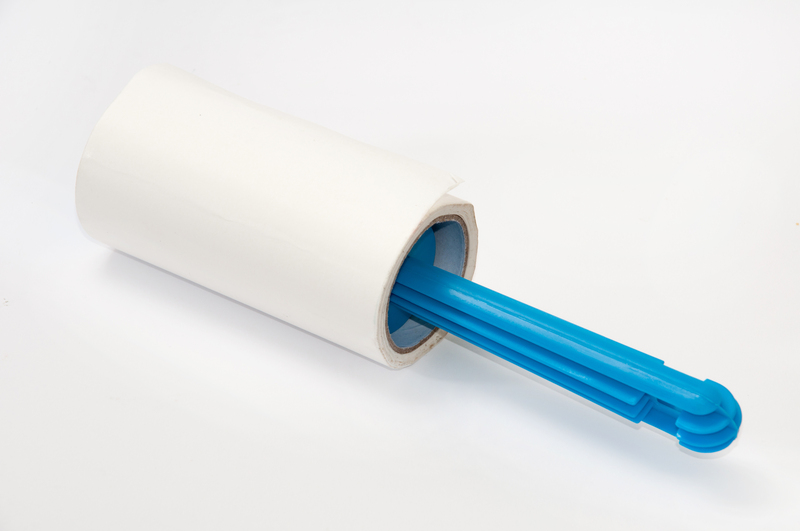Simple and Effective Ways to Clean Mould from Window Sills
Posted on 29/08/2025
Simple and Effective Ways to Clean Mould from Window Sills
Mould on window sills is more common than you might think, especially in damp or poorly ventilated spaces. Not only is mould unsightly, but it can also pose health risks and damage your windows. If you're looking for simple and effective ways to clean mould from window sills, you're in the right place. This comprehensive guide will provide you with pro tips, easy-to-follow steps, and prevention strategies to keep your window areas mould-free.
Why Does Mould Grow on Window Sills?
Before jumping into how to clean mould from window sills, it's crucial to understand why it forms there in the first place. Mould thrives in moist, humid environments, especially where there is little air circulation. Window sills are prone to condensation, making them a favourite spot for mould spores to settle and grow. Dust, organic debris, and even paint chipping can further fuel its growth. Some common contributors to window sill mould include:
- Poor ventilation
- Excess indoor moisture or humidity
- Condensation on windows during temperature fluctuations
- Leaky windows or inadequate seals
- Lack of regular cleaning

Health Risks of Mould on Window Sills
Ignoring mould on window sills is never a good idea. Mould spores can cause several health problems, especially for people with allergies, asthma, or compromised immune systems. Health issues linked to window sill mould include:
- Respiratory irritation or infections
- Allergic reactions (sneezing, itchy eyes, skin rashes)
- Headaches and fatigue
- Worsened asthma symptoms
Removing and preventing mould from window frames not only protects your family's health but also prolongs the life of your windows and keeps your living space looking fresh and clean.
Preparing for Safe Mould Removal
Cleaning mould can release spores into the air, so safety is essential. But don't worry - with the right approach, you can easily tackle mould on window sills yourself. Here's what you'll need before you begin:
- Rubber gloves
- Protective eyewear
- Face mask (preferably N95 or similar)
- Old clothes or protective clothing
- Spray bottle
- Soft brush or old toothbrush
- Microfiber cloths or disposable towels
- Plastic bag for waste
Simple and Effective Ways to Remove Mould from Window Sills
Now, let's get down to the best methods for cleaning mould from window sills. Whether your window sills are made of wood, PVC, or aluminum, these solutions will work - just adjust your scrubbing method to avoid scratching delicate surfaces.
1. White Vinegar: An All-Natural Mould Cleaner
White vinegar is a powerful, natural way to clean mould off window sills. Its acidity helps break down mould and prevents it from returning. Here's how you can use vinegar for a green, effective cleaning routine:
- Pour undiluted white vinegar into a spray bottle.
- Spray the affected area thoroughly, saturating all visible mould patches on your window sill.
- Let the vinegar sit for at least 1 hour. This gives it time to kill the mould spores.
- Scrub gently with a brush or old toothbrush, focusing on corners and cracks.
- Wipe clean with a damp cloth and pat the area dry.
Tip: If the vinegar smell is too strong, open your windows or add a few drops of essential oil (like tea tree) to the spray bottle.
2. Baking Soda: For Gentle, Residue-Free Cleaning
Baking soda is not only safe for most surfaces but also acts as a mild abrasive, ideal for sensitive window sill materials. Plus, it deodorizes and absorbs lingering moisture.
- Mix a tablespoon of baking soda with a cup of water in your spray bottle.
- Shake well to dissolve the powder.
- Spray the solution directly on the mouldy spots.
- Scrub with a brush or sponge until the mould lifts.
- Wipe the area clean and allow it to dry naturally.
Bonus: For persistent mould stains, make a paste of baking soda and water, apply it, let it sit for 10 minutes, then scrub and wipe away.
3. Hydrogen Peroxide: A Stronger Alternative for Stubborn Mould
Hydrogen peroxide is an effective antimicrobial, and it's safe for most window sill materials. It's slightly stronger than vinegar or baking soda, so use it for larger or stubborn infestations.
- Pour 3% hydrogen peroxide into a spray bottle (don't dilute).
- Spray generously onto the mouldy area.
- Let it bubble and sit for 15-20 minutes - this is the solution breaking down the mould.
- Scrub off mould residue with your brush.
- Wipe away excess liquid, then let the sill dry thoroughly.
Caution: Test a small area first, as hydrogen peroxide may bleach painted or old wooden surfaces.
4. Commercial Mould Cleaners: For Severe Infestations
If natural solutions don't work, you can use a store-bought mould remover. These products are designed to tackle tough mould growth, but ensure they're suitable for the material of your window sill.
- Follow the instructions on the label carefully, ensuring plenty of ventilation.
- Wear gloves and a mask, as commercial cleaners can be harsh.
- Keep children and pets away from cleaned areas until they're completely dry and aired out.
Remember: Never mix different cleaning products, especially those containing bleach or ammonia.
5. Soapy Water: Quick Fix for Light Mould
For mild cases, simple dish soap and warm water can often do the trick for cleaning black mould off window sills quickly.
- Add a few drops of mild dish soap to warm water.
- Dip a cloth or sponge into the soapy water and scrub away the mould.
- Wipe with a clean, damp cloth and ensure the area is dry afterward.
Step-by-Step Process: How to Clean Mould from Window Sills
Let's break down the mould removal process into simple, actionable steps:
- Open windows for ventilation before cleaning.
- Put on protective gear: gloves, mask, and goggles.
- Remove loose debris using a dry cloth or vacuum (with a HEPA filter if possible).
- Choose and apply your preferred cleaning solution--vinegar, baking soda, hydrogen peroxide, or a commercial cleaner.
- Let the solution sit for the recommended time (see above for details).
- Gently scrub the surface, paying attention to corners and seams.
- Wipe away mould and cleaning residue with a clean, damp cloth.
- Dry the window sill thoroughly to prevent moisture build-up.
Special Considerations for Different Window Sill Materials
Wooden Window Sills
- Use gentle cleaning agents: Avoid saturating the sill or using harsh chemicals, as wood can absorb moisture and chemicals, leading to warping or discolouration.
- Dry thoroughly: Wood must be dried completely after cleaning. Consider placing a fan nearby or opening windows for faster drying.
PVC or UPVC Window Sills
- Use non-abrasive sponges and brushes: Avoid scratching the plastic surface.
- Prevent staining: Most natural and commercial cleaners are safe but test a small hidden area first.
Aluminum Window Sills
- Prevent corrosion: Avoid leaving water or cleaning solutions to sit too long on aluminum.
- Rinse well: After using cleaning agents, wipe with a damp cloth to remove any residue that might dull the finish.
How to Prevent Mould on Window Sills
Once you've mastered removing mould from window sills, it's time to keep it from returning. Prevention is the key to enjoying a mould-free home. Here are effective prevention strategies:
- Ventilate your rooms: Open windows regularly, especially in bathrooms and kitchens, to reduce humidity levels inside.
- Use a dehumidifier: Keep indoor humidity between 30-50% for the best mould prevention.
- Wipe condensation: Use a towel or squeegee to dry window sills and panes when you spot moisture building up.
- Seal windows: Inspect and repair window seals to prevent water ingress.
- Clean regularly: Dust and wipe down sills weekly to remove spores before they turn to mould.
- Insulate windows: This prevents condensation, especially during colder months.
When to Call a Professional
While most instances of mould on window sills can be handled with the steps above, there are cases where you should consider professional help:
- Repeated mould growth despite regular cleaning
- Mould spreading across walls, floors, or extensive areas
- Strong musty odour that doesn't disappear after cleaning
- Concerns about black mould toxicity (Stachybotrys chartarum)
- Underlying leaks or structural issues contributing to mould growth
A professional mould remediation service will use specialized equipment to remove mould safely and address root causes so that it does not return.

Frequently Asked Questions About Cleaning Mould on Window Sills
Can I use bleach to clean mould off window sills?
Bleach can be effective at killing mould on non-porous surfaces but is not recommended for wood as it might damage the finish and doesn't penetrate the surface to kill all spores. Natural alternatives like vinegar or hydrogen peroxide are usually better choices.
Is it safe to paint over mould?
No, painting over mould is not a solution. The mould will continue to grow beneath the paint, eventually reappearing and possibly causing further damage to the wood or sill material.
How often should I clean my window sills?
To prevent mould from growing on window sills, aim to dust and wipe down your window sills at least once a week and deep clean monthly or as needed.
What if mould keeps coming back?
If you continually find mould on your window sills, you may have an ongoing moisture issue. Address all sources of excess moisture--repair leaks, improve ventilation, and use a dehumidifier.
Conclusion: Enjoy Mould-Free, Sparkling Window Sills
Removing and preventing mould on window sills doesn't need to be a daunting task. With simple and effective ways to clean mould from window sills using everyday household products, you can banish unsightly mould and protect your home's health. Remember to act quickly at the first sign of mould, use proper protective equipment, and maintain a preventive routine. By following these easy steps, your window sills will remain fresh, clean, and mould-free all year round.
For more tips on home cleaning and maintenance, bookmark this guide and keep your windows--inside and out--in their best possible condition!



